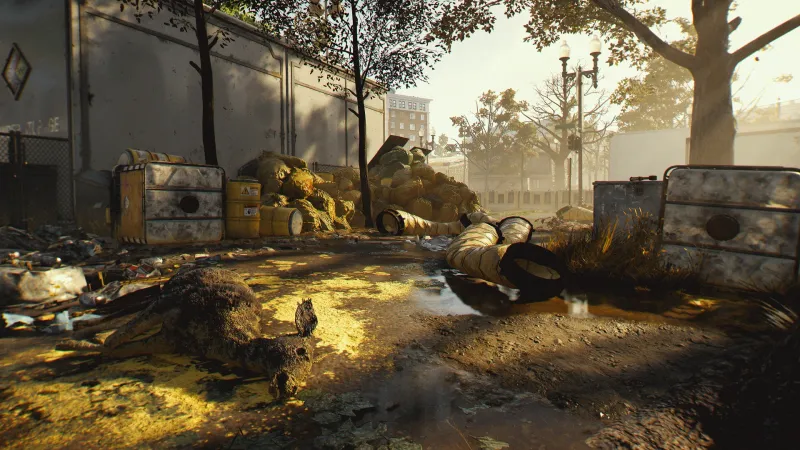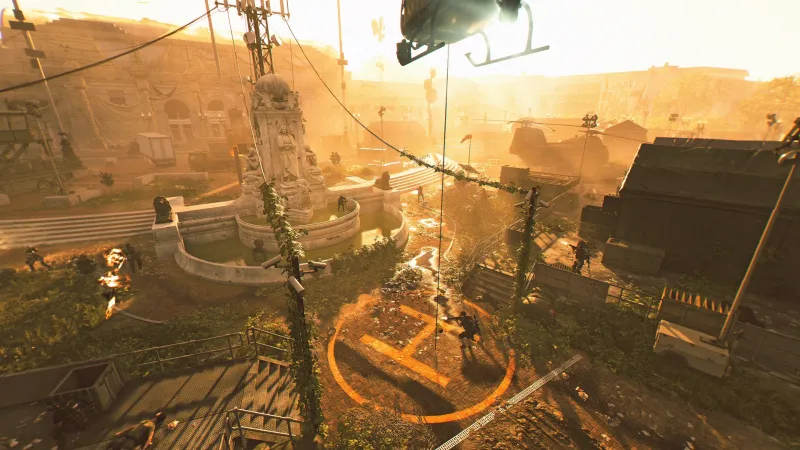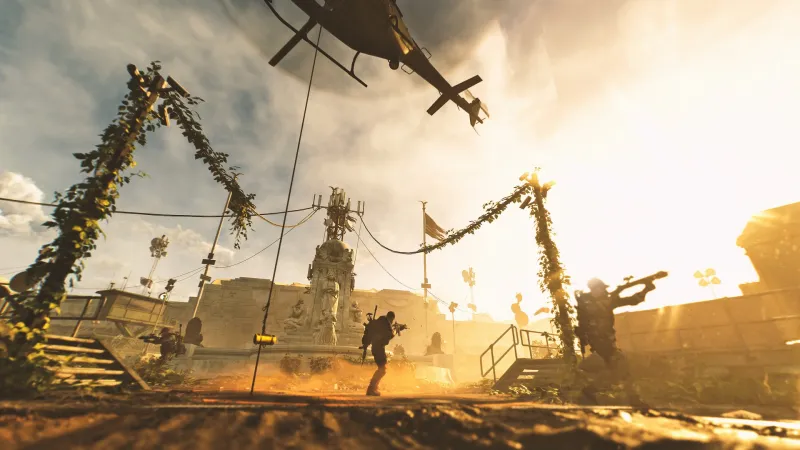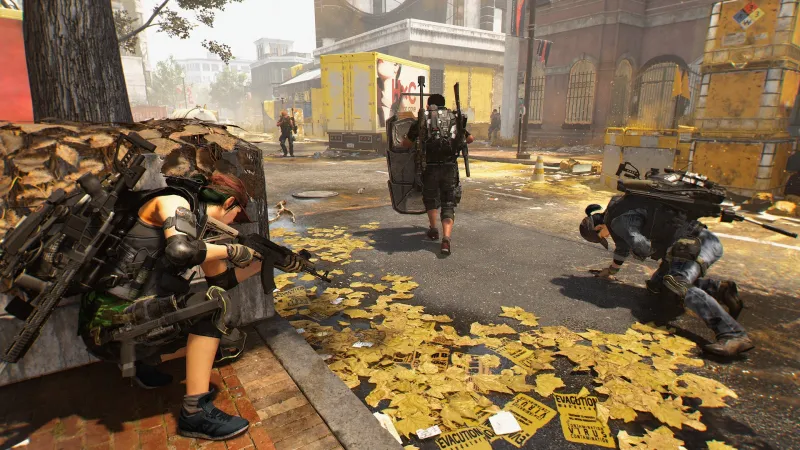

Our extra-large special edition is here. Subscribe today and receive the 25% longer issue at no extra cost!

The Division 2 is quickly barreling toward its March 15 release date, but up to this point Ubisoft and the developers at Massive and Red Storm have still kept many details close to their vests. Some of these dark zones are now receiving the spotlight thanks to a recent event that highlighted how the multiplayer spaces are changing for the sequel. After several hours of hands-on time, we have more than a few answers to our questions. Here is everything you need to know about how the dark zone is evolving in Washington D.C., how the development team hopes to make this element of the game more accessible, and the first look at the new PvP modes.

In The Division, Manhattan had one large dark zone parked in the middle of the map that players could access from all sides. Rather than replicate this layout in Washington, D.C., Ubisoft took a new approach by creating three smaller dark zones in various parts of the region. Each dark zone has its own origin story, unique biome, and emphasized gameplay style.
Dark Zone East is located at the Capitol Train Station. This is where the military set up during the green-poison outbreak to shuttle supplies around the city. With long sightlines and open spaces, this region is ripe for mid- to long-range combat.
Dark Zone South is located down by the waterfront. This is the epicenter of the green-poison outbreak in Washington, D.C. Over the last several months, storms, flooding, and “other terrible things” occurred in this area. Now, the waterfront is choked with overgrown vegetation. This area accentuates close-quarters encounters with its deep interior spaces more reminiscent of the first game’s Underground area and tight streets that provide cover every couple feet.
Dark Zone West (pictured above) is found in the residential area of Georgetown. Here, you take the fight to backyards, block streets, and alleys. Georgetown was the first test-bed for a government-created compound called DC62, which was sprayed across the neighborhood in hopes of neutralizing the green poison. Problem was, it also proved deadly. Expect a lot of medium-ranged combat here.
Each of these dark zones is much smaller than the large one in the first game, which means there are some density changes. Though you still have pathways should you want to move undetected, you’re going to have to exercise patience because all the landmarks, supply drops, and extraction points are by nature grouped much more closely together. The maximum number of human players in each dark zone is 12. Red Storm hopes this smaller player pool is offset by a greater assortment/number of A.I. threats in the regions.

Those who played The Division knew that anything could happen in the Dark Zone, the dangerous quarantine area in the middle of the map where the toughest enemies and best loot was found. Even after doing all the hard work of fighting through tough defenses and acquiring a valuable contaminated item for extraction, an opposing squad of agents (or even one of your own compatriots) could decide to put a bullet in your skull during the extraction and take the spoils for themselves. This created a riveting tension that attracted those brave enough to roll the dice, but it also drove many players away who preferred a more controlled experience.
Ubisoft isn’t content with the dark zones being play spaces for only a hardcore slice of its player base, which is why they are integrating the dark zones into the story missions. Each of the three dark zones has a narrative-driven introductory mission where you can venture into the zone with some cooperative buddies to get the lay of the land. During these private missions, you can explore the dark corners of the zones to your heart’s content, identifying the landmarks, finding the safe rooms, and locating extraction zones without worrying about being descended up on by rogue agents. Once you complete these missions, the dark zones transition into being the dangerous PvEvP space we’re all accustomed to. But having a private mission in the dark zone alone isn’t enough to tempt players to venture into the danger zone. Ubisoft also made other changes to entice wary gamers into the dark zone, most notably…

You no longer need to walk into a dark zone in fear of being destroyed by a Division lifer who has already min-maxed gear to the best of their ability. Ubisoft wants to make sure the dark zone is an even playing field no matter how many hours you’ve put into the game, which is why it has created a new weapon-normalization formula to balance out damage stats in the dark zone.
When you walk into the dark zone, your gear still works like you expect it to. However, all assault guns, sniper rifles, etc. are balanced to output similar damage. This rewards twitch play rather than whoever has spent more time with the game.
The weapon normalization does not happen behind a veil of secrecy. In the menu system, you can view how your weapon stats change in the dark zone at the press of a button, allowing players to make adjustments and see what happens.
The biggest potential benefit to weapon normalization is the diversity of builds we may see in the dark zone moving forward instead of seeing so many players using the same D3FNC style equipment.

Hardcore Division players probably scoffed at the idea of weapon normalization in the dark zone – how are they going to peacock their amazing gear sets when all the gear is re-rolled to the same basic level? The good news for these players is many at Red Storm feel the same way as you, which is why the game will have rotating “occupied” dark zones that have no rules.
Once you reach the endgame in The Division 2, one of the dark zones becomes occupied. We don’t know what this means narratively just yet (Aliens? Foreign governments? A power grab?), but we do know that it creates a no-holds-barred experience where friendly fire is on at all times, normalization is thrown out the window, and players can experiment with builds to their heart’s content.
“We have to respect the players who still play today, who still go in the dark zone today, to really blow off steam and flex and reap the benefits of all the optimization they have done on other people's faces,” says Red Storm creative director Terry Spier. “Give it to them, let them play as hard as they want to play. And take all the gloves off – everything. The A.I. is harder. The PvP is harder. The signs and feedback are harder. That intensity appeals to me so much. I think it's going to be crazier than the dark zone was when we launched the original game.”
No players have shade icons in these occupied zones, which means you have no idea what they are up to. Are they friendly? Are they manhunters? You never can tell until they act, adding yet another layer of tension to the experience.

If you ventured into the dark zone in The Division, chances are you worked real hard to recover some contaminated gear and marched it to the extraction zone only to have a rogue group of agents take you out and pilfer your goods. There’s no way around it – getting robbed sucks. Conversely, successfully extracting a rare item feels so goddamn good.
Ubisoft wants to preserve this feeling of empowerment, but at the same time wants players to feel rewarded for going into the dark zone whether they can extract some rare gear, which is why not every item you recover in the dark zone is contaminated. Ubisoft hopes this makes the contaminated items you do recover feel more valuable.
“Quite frankly, I was disappointed that yellow bag started to mean a little bit less in the original game because players had everything they wanted, nobody really cared, and they were just killing each other for killing's sake,” Spier says. “Making it so when you saw a yellow bag, you say, "Oh, that dude has a contaminated item!" and how we're handling the loot rolls on those contaminated items is different than it was in the original game. We're taking a look at who extracts that item, and then we're going to roll it after they successfully get it out. The likelihood that you get an upgrade is much higher.”

The rogue system from The Division operated on a simple premise – if you killed a rival player in the dark zone, you were branded a rogue. Rack up enough PvP damage and a manhunt quest would trigger for players in the surrounding area, putting a bounty on your head for them to collect. The Division 2 is making some significant expansions to this system to encourage different types of gameplay experiences.
This time around, you don’t need to be interested in PvP play to use the rogue system. You know all those pesky locked chests littered around the dark zone? If you don’t have a key, this time around you can pick the lock and steal the goods. The same goes with the supply drops – you could share with others or hoard it all for yourself. Doing so activates a new rogue state that still opens you up to attacks without consequences for other players. But doing so has another benefit: There are several hackable computer systems littered throughout the darkzone. Successfully hack enough of them and you gain access to a hidden thieves den, where you can collect potentially valuable loot and interact with mission givers who will reward you for recovering particular items.
The manhunt system has also been changed to reward emboldened players. When a player is designated as a manhunter, three shade terminals activate around the dark zone. One of these must be activated by the player to clear the manhunt status and claim the reward. The player knows where these locations are, but the bounty hunters only know it’s in a general vicinity. When a player reaches the first terminal, they can choose to clear the bounty or choose to increase their notoriety.
“We're essentially letting people ante-up and increase the rewards you can earn,” Spier says. “When you do that, the players chasing you will see you have done that and that one station goes offline and you only have two left. They still don't know which one you are going to, but there is an interesting cat and mouse game that's played by the manhunt folks and the people who are chasing them. Depending on how aggressive the manhunters want to be, they can earn a sizeable award if they increase their notoriety twice if they end up at one station where everyone on the server knows where they are going to be. It's pretty lucrative and it's super intense.”

Ubisoft is making some infrastructure changes to make the dark zone more hospitable. The reworked client/server architecture gives the developers the flexibility to handle more things server side, which eliminates the ability for users to modify data without getting caught. Both internal and third-party anti-cheat programs are being used to better identify and ban cheaters as well.
On the toxicity front, Ubisoft is making one critical change to voice chat. You can still talk to strangers in the dark zone, but once bullets are exchanged between parties they can no longer talk to each other. This should hopefully cut down on the amount of trash talking you hear on a nightly basis.

The oft-requested clan system is finally becoming a reality in The Division 2. Setting up a clan with friends gives you unique leaderboards where you can compare accomplishments as well as a unique progression track. Clans earn XP for completing objectives and activities together, which unlocks special collaborative objectives, special clan perks, and exclusive clan cosmetic items.
“We want to make sure that people who participate in the clan feature can be as flamboyant as they want to really deck out their character and make sure they can be as proud as they want of their organization,” Spier says.
Clan members can communicate with each other via clan chat, direct messaging, and a bulletin-board system. The clan system lacks the ability to matchmake and scrimmage other clans, but Ubisoft’s goal is to eventually have it integrated with all the features in the game.

When multiple squads and A.I. waves descend on the same position, the user interface overlay can get very cluttered and obscure your view of the action. Thankfully, both PC and console users have access to HUD customization that allows you to reposition (or even remove) certain data points.

For squads who want to test their mettle against rivals in the purest of environments, Ubisoft has crafted Conflict. This organized PvP suite pits two teams of four against one another in two modes – Skirmish and Domination. As you would expect, Domination follows the familiar flag-capture formula found in many competitive shooters. Skirmish is essentially a team deathmatch mode that culminates in a single-elimination event.
Ubisoft plans to have three unique maps available at launch, with plans for more maps and modes in the future. These locations are discrete instances that take place off the mega-map.
Like the dark zone, the PvP battles use stat normalization to even the playing field. Skill-based matchmaking should group you with players with similar abilities, and the unique progression track in Conflict includes exclusive vanity awards you can’t get elsewhere.
To learn more about The Division 2's new dark zone and PvP spaces, read our interview with Red Storm creative director Terry Spier.

Explore your favorite games in premium print format, delivered to your door.